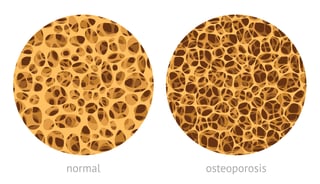
COPD and other respiratory or inflammatory related diseases often require the use of corticosteroids for treatment. Though these treatment regimens are quite successful they do have an unfortunate side effect. They have been linked to the increased risk of bone loss, more commonly known as osteoporosis.
What is Osteoporosis?

Osteoporosis literally means, “porous bone”. This disease occurs when the body loses bone, fails to produce bone, or sometimes both. When viewed under a microscope, healthy bone tissue resembles a honeycomb. In bone that has been afflicted with osteoporosis, the bone has large holes and spaces, making it very brittle and easy to break and fracture. A fall, bump, or even a sneeze can fracture brittle bone that is riddled with osteoporosis.
As bones get weaker, so do the muscles. As a patient loses muscle mass more pressure is put on the skeleton which magnifies the problem and increases fracture risk even more.
The Causes of Osteoporosis
Osteoporosis is commonly thought to be a common condition associated with aging and decreasing estrogen levels in postmenopausal women. However, a recent study reported in the medical journal, University Health News Daily, reported that use of steroid drugs, such as prednisone, are now proven to be an underlying cause of secondary osteoporosis. Secondary osteoporosis is defined as osteoporosis that is caused by a disease, deficiency, or in this case, a drug. One frightening statistic from NYSOPEP (New York State Osteoporosis Prevention and Education Program), states that almost 1 in 3 postmenopausal women who use steroid medication, will have a spine fracture. Other Statistics include:
- A steroid user is more than twice as likely to have a spine fracture as a non-steroid user.
- Ingesting 10 mg of prednisolone daily for 3 months increases the risk of hip fracture by 7 times.
- The same dose will increase the risk of lumbar fractures by a staggering, 17 times.
What are Corticosteroids?
Corticosteroids are a family of drugs that are prescribed mainly to treat inflammatory conditions. They are commonly used to treat asthma, autoimmune diseases, joint disorders, and most inflammatory respiratory conditions, such as COPD. They are synthetic versions of adrenal steroid hormones such as cortisol, and cortisone. These steroids are not to be confused with the steroids that athletes sometimes use to build muscle, which have a whole other set of risks.
conditions. They are commonly used to treat asthma, autoimmune diseases, joint disorders, and most inflammatory respiratory conditions, such as COPD. They are synthetic versions of adrenal steroid hormones such as cortisol, and cortisone. These steroids are not to be confused with the steroids that athletes sometimes use to build muscle, which have a whole other set of risks.
How do Steroids Affect Bone?
As we have stated, regular use of steroid based medications can lead to bone loss. These medications have major effects on how the body metabolizes calcium and vitamin D. These are two of the most essential minerals for maintaining healthy bones.
Does how you take the Medication Make a Difference?
Studies have shown that inhaled corticosteroids are less likely to cause bone loss then those taken orally but an increased risk factor still does exist. Even the use of topical steroids for skin conditions do present some risk of increasing the chances of developing, or increasing the severity of bone loss.
What Other Side-Effects can Corticosteroids Have?
In most studies patients who are long term users were surveyed or tested. Long-term is generally defined as longer than three months.
- Weight gain coupled with increased appetite
- Nervousness
- Elevated blood pressure
- Suppressed wound healing
- Fluid retention
- Indigestion
- Increased risk of fungal infections
- High blood sugar
What Increases the Risk of Bone Loss?
- Excessive alcohol consumption
- Tobacco use
- Sedentary lifestyle
- Genetic predisposition
- Poor nutrition
What to ask your Doctor
Though it is scary to think that the medication that makes it easier for you to breathe is  also detrimental to your bones, the good news is that there are steps that can be taken to prevent or slow bone loss.
also detrimental to your bones, the good news is that there are steps that can be taken to prevent or slow bone loss.
- Ask the doctor to prescribe the lowest possible dose for the shortest period of time.
- Request a bone density test.
- Discuss the possibility of getting prescribed an osteoporosis drug.
- Speak to a nutritionist about vitamin D or calcium supplements.
What is a Bone Density Test?
This test is the only one that can diagnose osteoporosis before a broken bone occurs. X-rays are used to measure how many grams of calcium and other essential minerals are packed into a given segment of bone. Usually technicians test the hip, spine, and occasionally the forearm.
When is a Bone Density Test Recommended?
Your physician may recommend a bone density test in the following circumstances.
Losing Height: losing height may be a result of spine compression fractures.
Bone Fracture: if you've had a fracture occur much more easily than expected, your bones may be losing density.
Medications: if you've been prescribed some of the drugs we've discussed above, your doctor may want to assess their effects on your skeletal system.
Menopause or Other Hormone Change: a drop in hormones can lead to increased risk of bone loss. In addition to natural drops due to menopause or decreased testosterone in older males, cancer treatments can also lower sex hormones.
Transplant Recipient: those that have received an organ or bone marrow transplant have an increased osteoporosis risk due to anti-rejection drugs which interfere with the bone formation process.
Proactive Measures
Aside from whatever your physician suggests there are several other steps that you can take to prevent, or at lease slow bone loss. We'll be outlining strategies in further installments of this series.



